Warm weather is around the corner, which means pests that have been overwintering or hibernating will wake up as well as non-hibernating pests will start making an appearance outdoors. Being prepared for those spring and summer pests can have an impact on how enjoyable your time will be at home or at work.
Using industry leading expertise, we have put together a comprehensive list on the top 9 pests expected to trend in the summer of 2023. This list will provide a deeper dive into the impact that pests can have on your property, along with prevention tips to keep your home or business pest-free.
Reason For Possible Pests To Trend In The Summer Of 2023
There are two factors that come into play when determining the reason for pests to trend during the summer of 2023, temperature and precipitation.
The winter of 2022 had been mild, but towards the end, the weather was more erratic with weekly snowstorms being present through parts of Canada. Though there have been storms through parts of the country, the temperatures have been above average, with snow from the many of the prior storms melting rapidly each week.
These mild temperatures have had an effect on bodies of water such as the Great Lakes. This is because when the winters (such as the winter of 2022) are mild or if temperatures are above average and snow comes late in the winter, large bodies of water like the Great Lakes are not covered with sufficient snow or ice; rapid snow melt and spring precipitation can make the lakes susceptible to flooding.
This may have a negative effect on low lying towns, cities and all the areas around these large bodies of water. Also, the repeated last winter storms and rapid snow melt causes over saturation of the soil; compounded with spring precipitation, there is potential for flooding even for areas away from the Great lakes.
These flooding risks can create breeding grounds for pests, passively spread pests, flush pests out of their natural habitats into buildings, compromise building structures, leaving openings for pests to infest residential and commercial properties. Rapid snow melts from rooftops and structures can damage structures making them susceptible to pest infestations.
*It is important to note that a lot of the current predictions about the expected wave of pest activity in 2023 is anecdotal/based on expected conditions.
Quick Links
Top Pests To Expect In The Summer Of 2023
Ants
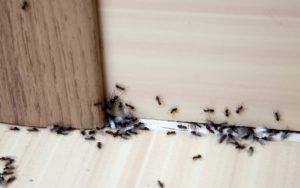
Why Ants Are Expected To Trend
The winter of 2022 had been mild, but with sporadic snowstorms and higher than average temperatures, rapid snow melt created excess moisture and run-off can result in interior and exterior structural damages. The water saturated soil and anticipated spring precipitation might aggravate flooding. Most ant species are attracted to moisture. Therefore, moisture compromised wood structures resulting from snow melt and flooding will attract and provide nesting grounds for wood-infesting ants such as carpenter ants and acrobat ants. Excess moisture indoors can attract pavement ants and moisture ants. Flood waters can also passively spread ant colonies as debris and chunks of soil float along; this is especially true for fire ants.
What Makes Ants Dangerous?
Ants are not only unsightly and a nuisance when found indoors, but can contaminate food and beverage products. A few species such as pharaoh ants have been implicated in disease transmission, especially in hospital and long-term care facilities.
Outdoor colonies can damage lawns and gardens, as well. When dwelling indoors, ants may cause damage to the structure by chewing wood, insulation, and electrical cables during nest building.
Some species of ants are capable of inflicting painful stings. Some individuals may develop inflamed skin at sting sites and experience cramps and headaches as reactions to ant venom.
Prevention Tips To Keep Ants Out
- Perform spring cleaning and inspect for water damage to structure: roofing, ceiling, walls, basement, crawl space yard wood fences.
- Repair indoor water leaks, correct moisture problems.
- Remove and eliminate rotting wood logs or old tree stumps from property.
- Clean up crumbs and spills promptly.
- Store food in tightly sealed containers.
- Rinse food containers before recycling.
- Repair all cracks in walls and foundations.
- Keep entry points sealed.
Rodents
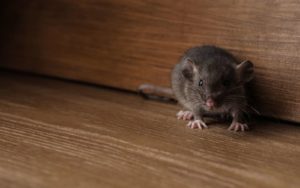
Why Rodents Are Expected To Trend
Cold winters naturally control pest populations, consequently less pest population will survive to establish spring population. The milder winter conditions of 2022 most likely helped the survival of high outdoor populations of rodents, which implies stronger population growth for the spring and more activity during the summer. Also, subsequent precipitation and flooding risk may result in rodents looking to seek shelter inside residential and commercial properties.
What Makes Rodents Dangerous?
Rodents can carry and transmit a variety of diseases including the Hantavirus, a rare respiratory disease, in their saliva, urine, and faeces. This disease can be fatal in humans and there is no known cure.
Rats and mice both contaminate food with their faeces, urine, and saliva, and can introduce ecto-parasites, such as mites, fleas, lice, and ticks into your home. Rodents can also cause structural damage to your home or business when they burrow through walls and gnaw through electrical wiring, causing power outages, starting electrical fires, and forcing expensive repairs.
Prevention Tips To Keep Rodents Out
- Keep food prep and handling areas clean by tidying up spills and crumbs immediately; do not leave foods in the open.
- Remove easily accessible food sources, such as pet feeds, bird feeders and baths.
- Regularly clean waste receptacles.
- Use trash receptacles with lids and keep cans covered tightly at all times.
- Install weather strips around doors, windows and garage doors.
- Trim back vegetation from your home or building exterior.
- Keep flowerbeds and landscape well-manicured and maintained, it discourages harbourage.
- Eliminate clutters from yard or around building that may attract and provide harbourage.
- Inspect and seal openings around utility lines and pipe entry points into exterior wall.
- Ensure roof vents are screened.
- Drainpipes are screened.
- Seal any cracks or holes with caulk or foam.
Cockroaches
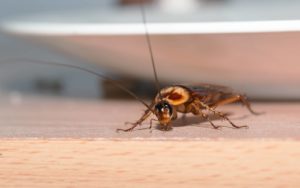
Why Cockroaches Are Expected To Trend
Whenever there is any kind of flooding, like what is projected to occur, cockroaches are expected to become an issue. These pests can get flushed out from underground sewer systems into structures in urban areas. The moist conditions created by floods can also make properties more attractive, as cockroaches are attracted to moisture.
What Makes Cockroaches Dangerous?
Cockroaches are unsanitary, as they harbour germs in their guts as well on bodies and can pose various health threats to humans. Consuming food and beverages contaminated by cockroaches may cause food poisoning, meanwhile cockroach faeces can also negatively affect the health of humans causing allergic reactions particularly for people with asthma.
They can also spread harmful bacteria, including coliform, salmonella, staphylococcus, and streptococcus, by crawling through garbage and sewers to food preparing and handling surfaces.
Cockroaches are resilient and can survive for weeks without food and water. Their eggs are also protected from treatments by an egg case, so even if you kill the adults, they’ll soon be replaced by new hatchets.
Prevention Tips To Keep Cockroaches Out
- Clean up crumbs and spills promptly.
- Clean-up grease and food build-up on, inside and behind kitchen appliances.
- Store food in tightly sealed containers.
- Make sure cupboards remain dry.
- Use a dehumidifier to reduce moisture.
- Fix leaky pipes and faucets to eliminate readily available water source.
- Take out the trash every day.
- Eliminate clutter, especially cardboard boxes, roaches love cardboard box clutter.
- Seal crevices and openings in walls and floors.
- Seal gaps around doors, in baseboards, around appliances.
Subterranean Termites
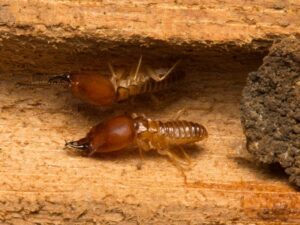
Why Subterranean Termites Are Expected To Trend
Subterranean termites nest in soil where they excavate tunnels through the soil to reach wood buried in soil or in close contact with soil; access building structures via cracks and cavities in foundation or concrete slabs. Persistent moisture is key for infestations.
Therefore, conditions such as flooding anticipated, over moisture saturated soils around structures, water damage from eaves and downspout from rapid excess snows melts as seen in winter of 2022 can create perfect conditions for subterranean termites to survive and thrive in areas where they were previously weren’t able to adapt.
What Makes Subterranean Termites Dangerous?
As the most common type of termite, subterranean termites cause millions of dollars in structural damage each year in North America. These pests feed on wood and readily use finished lumber as food, hence why they infest buildings, utility poles, furniture, books, paper, and other wood related structures.
Since these pests can often infest homes and businesses for years undetected, this can create serious safety and structural issues that could put your family or patrons at risk; treatment costs can run into the thousands and millions of dollars.
Prevention Tips To Keep Subterranean Termites Out
- Eliminate moisture sources indoors by fixing leaky plumbing and faucets.
- Eliminate water from around building foundation by ensuring all drainage flows well and away from the building by grading it.
- Inspect roofs for leaks, ensure drains, eaves and downspouts are not clogged for proper drainage.
- Eliminate wood debris or wood clutter from yard and around building.
- Eliminate wood debris or remains that are underneath soil, these attract foraging termites.
- Reduce or eliminate as much as possible structural wood-to soil contact, if possible, create a concrete barrier.
- Keep shrubbery and trees maintained so that the vegetation does not come in contact with the structure. This creates moisture coverage for termites.
- Avoid excess use of mulch because it traps moisture, making it ideal for foraging termites.
- Store lumber and firewood away from the building in a dry place and off the soil or ground.
Mosquitoes
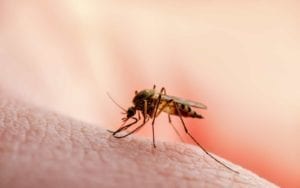
Why Mosquitoes Are Expected To Trend
With sporadic snow dumps and higher than average temperatures, soil conditions become oversaturated with water. As spring precipitation and warmer weather arrives, the moist and oversaturated soil can provide ideal breeding conditions for mosquito populations to thrive. Also, the mild winter means more overwintering mosquitoes and eggs survive to start a resilient spring population that will carry over to high populations in the summer.
What Makes Mosquitoes Dangerous?
Mosquitoes can cause painful bites that may cause inflammation. Their annoying buzz and vicious bites can prevent outdoors recreational or leisure activities. Reactions to the bites may result in secondary infections; in addition, some mosquito species can transmit pathogens such as plasmodium that causes malaria, West Nile virus, Encephalitis viruses complex, and filarial heart-worm in dogs.
Prevention Tips To Keep Mosquitoes Out
- Eliminate all standing water, including containers that hold water.
- Fill redundant ditches or holes.
- Trim back all tall vegetation.
- Retrofit storm drains and catch basins.
- Wear insect repellent and protective clothing.
Midges (Non-Biting)
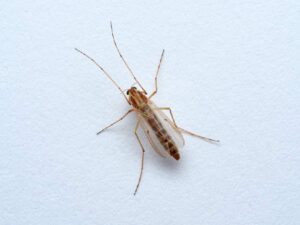
Why Midges Are Expected To Trend
Like mosquitoes, midges look for moist conditions to breed. With possible flood conditions expected in areas by large bodies of water, soggy or oversaturated soil or puddles with stagnant water can provide the perfect breeding environment for these pests to thrive.
What Makes Midges Dangerous?
Though these pests do not bite or transmit diseases, midges can be a nuisance due to their overwhelming numbers. These pests tend to invade homes and businesses in large numbers. They can become major product or food contaminates including the risk of entering people’s mouth, eyes and/or nose. These pests can make everyday activities like going into your car or sitting in your backyard impossible due to the sheer number of these pests.
Prevention Tips To Keep Midges Out
- Eliminate stagnant water sources.
- Trim back all tall vegetation.
- Seal any openings on the exterior of your property.
- Replace any worn window or door screens.
- Use yellow or less-bright exterior lights. Bright lights attract them to the building where they eventually enter indoors.
- Use decoy lights around building to pull them away from building.
Flies
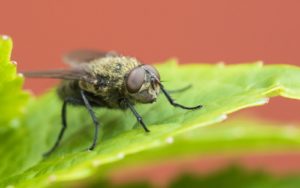
Why Flies Are Expected To Trend
The mild winter of 2022 means fly populations were not naturally controlled. This creates the potential for a large number of flies breeding earlier, which will give rise to higher fly populations in late spring into the summer. This surviving population is supported by exposed decaying garbage, organic matter and vegetation unmasked by melting snow and floods. The flies feed and breed in these moist decaying organic matter. These conditions across the country provide ideal breeding opportunities for flies to thrive.
What Makes Flies Dangerous?
There are more than 100 pathogens associated with flies including salmonella, staphylococcus, E. coli and shigella. These can cause typhoid fever, cholera, bacillary dysentery, hepatitis, ophthalmia, polio, tuberculosis and infantile diarrhea.
However, for every fly you see, there are an estimated 19 more flies hidden from view. Flies can also contaminate food, creating a serious reputation issue for business owners.
Prevention Tips To Keep Flies Out
- Spring clean-up around commercial buildings or homes, clean all decaying vegetation and garbage unearthed by snow melts and flooding.
- Good waste/garbage management, regular disposal, use receptacles with lids, do not allow garbage to overflow; this will prevent fly breeding.
- Locate garbage bins or dumpsters away from door entrances to prevent flies from getting indoors when the door is opened.
- Always keep doors closed.
- Replace broken windows and worn-out screens.
- Reduce the presence of ripe fruits and vegetables.
- Create an air current to prevent flies from landing.
- Close the lids on all garbage and waste containers.
Wasps
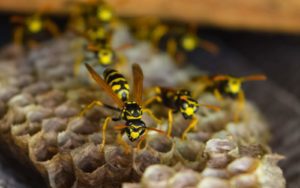
Why Wasps Are Expected To Trend
The mild winter of 2022 has resulted in fewer wasp colonies being naturally controlled. Wasp queens that have survived will come out early and they’re going to start populations earlier in the year.
The mild winter and early start of warm spring will lead to vegetation sprouting early in the season, with that there will be abundance of plant feeding insects on which wasps feed. Also, plenty of nectar or plant juices that can support early population growth. This plentiful of resources will support the thriving wasp population through the summer and fall.
What Makes Wasps Dangerous?
Wasps can be dangerous, aggressive and extremely territorial and removal of a wasp nest and eradication of a wasp infestation is best left to a professional pest control service.
Prevention Tips To Keep Wasps Out
- Seal all potential entry points to your home or business.
- Fix cracks around windows and doors.
- Repair door and window screens.
- Reduce available food sources, such as pests like flies, ants, and spiders.
- Clean up spills and crumbs promptly.
- Cover trash with tight fitting lids.
- Reduce available nesting sites and remove old, inactive wasp nests.
- Trim back bushes and vegetation.
Ticks
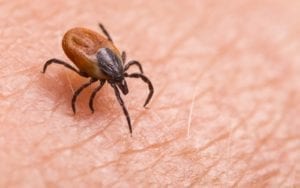
Why Ticks Are Expected To Trend
The mild winter of 2022 has resulted in fewer wildlife populations being naturally controlled as well as ticks. Ticks do not hibernate meaning they are able to feed on hosts for longer periods of time and survive the winter as well. This surviving population will create a second peak of tick populations in the early spring, which will eventually give rise to larger tick populations during the early summer and fall months.
What Makes Ticks Dangerous?
Ticks carry bacteria and viruses known to cause serious illness in both humans and animals, including Rocky Mountain spotted fever and tularemia, a potentially fatal infectious bacterial condition characterised by fever, weight loss, and ulcers.
Black-Legged Ticks (also known as the deer tick) are vectors of Lyme disease, which causes fatigue and may also lead to extreme problems with the central nervous system, and the neurotoxins they produce can cause tick paralysis and the loss of muscle function.
Prevention Tips To Keep Ticks Out
- Keep grass mowed, getting rid of all leaf and weed litter.
- Trim vegetation and tree branches.
- Manage pet activity to limit interactions with ticks.
- Wear proper clothing, keeping shirts buttoned and tucked into pants, and wearing proper footwear.
- Use tick repellents on any bare or exposed skin.
We hope these predictions will get you ready for the summer of 2023. Remember that if you are seeing a large-scale pest infestation on your property, your Orkin Pro is there to assist you. Contact your local Orkin Canada branch today to get started!
Remove pests from your home, and stop them from coming back
We work hard to listen, understand and assess your unique situation. Request a free, no-obligation estimate today for a customized pest program that fits your needs.
Request a Free Home EstimateRequest a Free Business Consultation

You may also like
Top 4 Tips For A Pest-Free Halloween
You may have been tricked by the plastic bats and fake spider webs in your neighbourhood, but the pests trying to make your house their home can be the scariest trick during Halloween. From rodents trying to trick or treat inside your home to flies trying to enjoy your jack-o’-lanterns, pests are always looking for ways to get into the Halloween spirit (and your home). Don’t worry, you’re not alone in trying to pest proof your home, as your Orkin Canada Pro has put together a list of 4 quick tips that will help you keep pests out this Halloween.
4 Easy Tips To Pest Proof Your Garden
Spring is the perfect time to get the garden tools out and start getting the garden box ready to grow some vegetables and your favourite flowers. You might do this every year, or this is your first attempt at gardening, regardless of your experience level, we're here to help you keep pests out. Our experienced Ph.d. entomologist Alice Sinia has put together a few easy and simple tips keep your garden pest free.
Practical Ways To Prevent Warm Weather Pests
Spring has arrived, and the pests are already starting to make their usual rounds. As they seek food, water and shelter, your home is like a bug and rodent oasis just waiting to be occupied. But nobody likes surprise invaders in their living space, which is why it’s crucial to recognize the most common threats and take action to prevent them.
Ants Frequently Asked Questions (FAQ)
What attracts ants into my home? How do I get rid of ants and prevent their colony from growing? Get the answers to the most frequently asked questions on ants, all answered by the experts at Orkin Canada.
Remove pests from your home, and stop them from coming back
We work hard to listen, understand and assess your unique situation. Request a free, no-obligation estimate today for a customized pest program that fits your needs.
Request a Free Home EstimateRequest a Free Business Consultation

